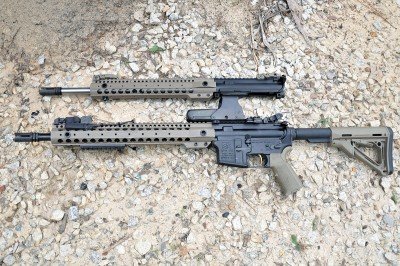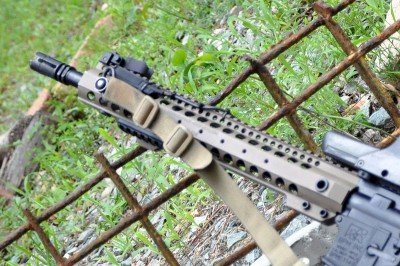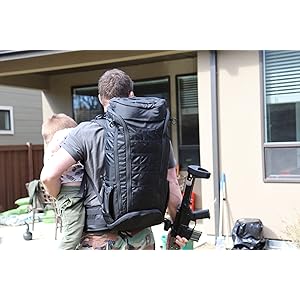[one_half padding=”0 0 0 0px”]
Barnes Precision
[/one_half]
[one_half_last padding=”0 0 0 0px”]
[/one_half_last]
Recently, GunsAmerica has been diving into all things 300 Blackout. Today’s spotlight is on a very special set from Barnes Precision Machine–an AR-15 with uppers in both 5.56 and .300 AAC Blackout. Why two upper receivers? That is the brilliance of the Blackout. 300 AAC, designed from the ground up to work with all existing AR-15 components except the barrel. Magazines, bolt, and all the internal parts are identical. If it was easier to switch barrels in an AR-15, I could use any existing AR I own for 300. In fact, the company that provided the ammo for this test uses cut down 5.56 brass to produce its .300 AAC case. Also by design, you cannot easily chamber a 300 round in a 5.56, or vice versa due to case shoulder dimension. But that still hasn’t answered the question at hand. Why two uppers?
A CARTRIDGE FOR ALL OCCASIONS
5.56 and 300 AAC compliment each other across a wide range of tactical solutions. I believe Blackout will soon become the weapon of choice for law enforcement–it was practically purpose-built for urban use. Inside of 250 yards, there is not much difference in the trajectory of these two rounds. But the Blackout is packing, on average, twice the bullet weight. Inside of 100 yards (most every law enforcement shooting I have ever heard of is inside this range), you also have the option of subsonic ammo. 300 AAC is available in up to 220 grain subsonic, which is a lot of oomph for such a small package.

One barrel is stainless–the other is black. While simple, the color of the barrel is an easy indicator of caliber.
Subsonic, even without a sound suppressor, is surprisingly quiet. You would still want to wear hearing protection, but the sound is significantly less than standard velocity ammo in either caliber. As an urban combat round, Blackout truly shines. The only real down side to Blackout for this application (at the current time) is the price. Blackout averages out around 82 cents per round as opposed to 33 cents for 5.56. And Urban Combat training requires shooting. Lots of it.
That’s the first reason. It is easy to train with 5.56. By simplified math, it takes me 2 cases of 5.56 to pay for my second upper receiver. I specifically ordered my 5.56 and 300 uppers to be identical for this reason. I can train relatively cheaply with my 5.56 gun, and then slap on the Blackout upper and I am ready to go. All of my CQB training has been done with an identical gun, but I am packing a much harder hitting round when its time to ride the breech. This also saves wear and tear on my go to work gun. Upper receiver parts rarely break, but it can happen. At the end of the day, I would much rather go into harms way with a gun having shot 500 rounds instead of 5,000.
What if don’t see a lot of CQB action?
The same holds true for hunters. I shoot from the prone when I am accuracy testing a gun, but I have never shot an animal from that position. And very rarely a person. Unfortunately the real world doesn’t look like a golf course. Back in USMC sniper school, the instructors called it perfect world prone, and they were right. Once a gun is zeroed and we have learned how to pull the trigger, practicing the prone position doesn’t do a lot for us.
300 AAC is a better choice than 5.56 for any large animals such as hogs or deer, but I dislike spending close to a dollar per trigger pull practicing shooting positions. Recoil is very similar in these two platforms, so using the 5.56 for training and the 300 for hunting is a very viable option. As a hunting platform, you could also build an upper receiver for different occasions. An 18-20 inch 5.56 for varmint and longer range shooting, a 14.5 inch pinned flash suppressor (or shorter with SBR paperwork) 300 AAC for larger game. Blackout doesn’t depend on velocity so much as bullet weight, and as such is much more viable in a short barreled weapon. 300 AAC is hell on hogs.

One you’re comfortable punching paper, you have to move to more practical training. The low cost of the 5.56 will be a plus.
Why not be ready?
From a survivalist standpoint this set up also makes a lot of sense. At a savings of 5 pounds ( for the lower receiver), you gain the ability to use two kinds of ammo. It would also make sense to set up the 5.56 receiver as a DMR style weapon with a scope, using the shorter 300 receiver with a red dot as your urban combat gun. Switch between uses only takes about 30 seconds. If you buy the second upper complete with a bolt (identical to both guns), switching over is even faster, and you are carrying the most needed spare parts in an AR-15.
Let’s go back to the question. Why two uppers instead of two guns? Price. Outside of the barrel and hand guard, what are the two next most expensive parts on a AR? The trigger and the stock. A good stock can set you back $200-300 dollars, and so can a trigger. I always put AR gold triggers into my guns, and next to the barrel the trigger is the biggest component of accuracy. Quality is not cheap though, and this is one place where you should not skimp. I have seen plenty of cheap triggers rattle apart in short order, and its never pretty. For any type of working gun, I want the best stock I can lay hands on, one that will take some abuse. My current favorite is the Magpul UBR, which retails for $265. Those two components together are not cheap, but you only have to buy them once.

Barnes Precision makes solid rifles that have built a well deserved reputation for quality and dependability.
BARNES PRECISION MACHINE
The BPM rifle used in this article is truly a thing of beauty. It seems like everyone under the sun makes an AR these days, but no one does it like BPM. Barnes Precision is famous around the Fort Bragg area for accuracy and tight tolerances, as well as taking care of the troops when they need something. I won’t bore you with group sizes, but both these uppers were well under MOA accurate. The fit and finish have to been seen to be believed. The uppers are so tight it actually helps to squeeze the two halves of the gun together to get the take down pins out.
My favorite part of the BPM gun though has to be the hand guard. A unique design of Andrew Barnes, the hand guard is perfect. It is small enough to grip hard in the modern thumb over manner, and only has rails on top to provide positive contact with your hand all the way around. Modular rail sections can be added where you need them, and the QD sling swivels are built into the hand guard itself. The hand guard is milled from one solid piece of aluminum, and is as hard as a coffin nail. Prized on both the race circuit and tactical market, it makes the gun feel like an extension of your body. Every machined part is built on site in Apex, NC, and every part in the gun is made in the USA. If you are in the market for a hell and back AR, give Barnes Precision a call.
And if you want to get the most out of your training, and hunting, and defensive preparations, check out the 300 Blackout.




I have owned Daniel Defense 16 in upper for 4 years. Originally I swapped the upper with a POF 5.56 lower. It worked fine, but I got tired of doing that. So I purchased a lower end Anderson lower and put a ELF trigger and JP enterprises buffer system. The JP enterprise buffer cut the suppressed noise from the action down dramatically. OBTW I also have an AAC SDN 6 suppressor.
The biggest problem I have is the suppressor forces a lot of combustion gas and soot into the action. The bolt, trigger and lower and even the magazine get a coating of grime that is difficult to remove I do not think you could get a 30 round magazine to empty without clogging.. In fact it caused the trigger to malfunction because the hammer was gummed up to the point it would not strike the firing pin consistantly. I cleaned everything in ultrasonic cleaner which took care of the problem, but I was wondering if anyone else had the same problem and or if there was a solution?
Do not get me wrong, I really like the 300. It is my preferred go to gun. I make brass out of range brass I pick up for free. Power primers and bullets lower my cost to around $.25 for subsonic and $.43 for subsonic using 208 grain Hornady A-Max. bullets. I have tried a variation of 125 grain bullets and it shoots great with both. It took a while to get the right powder for subsonic rounds to work, but there are many that work for supersonic. I like LitLgun the best. One thing you mus keep in mind is the barrel length makes a difference in velocity so you will probably have to hunt for proper load for your specific barrel. Also the carbine vs pistol gas tube system makes a difference. If you like to shoot and reload this is a lot of fun. At the range I see a lot of jaws drop when I shoot subsonic. Fun!!!
Love my 300 blackout AR and I can usually find 300 blackout ammo at wallyworld for reasonable price
Yay! Another 300 AAC Blackout fan! Welcome my brother! 🙂
the 300 blackout round is Much better than the 7.62x 39 round in a 16 inch barreled ar Platform, how do I Know? Because I had BOTH in a 16 inch AR from PWS with the long stroke gas piston system and the same exact triad muzzle brake and they Blackout was Consistently 50% More Accurate with 50% Less recoil as Well and was about 35% quieter as Well So all Around I Was Very Impressed w/ the Blackout and Ditched the 7.62×39 upper and Kept the Blackout upper 🙂
I think the .300 AAC BLK cartridge is better than the 5.56 x 45 round. The super sonic cartridge of the .300 AAC BLK is very effective to about 274 meters (or 300 yards). The round is effective beyond 274 meters as well. I think it is a good round because it gives you a better option over the 5.56 x 45 wounding cartridge using the same rifle receiver.
I would take a 125 grain bullet traveling at 2,230 feet per second muzzle velocity from a sixteen inch barrel over the 5.56 x 45 round.
I believe the author of the article lays out the benefits quite well for having a .300 AAC BLK upper to tag along with your 5.56 rifle. I discovered this benefit a long time ago when the Blackout was making it’s way onto the shooting scene. Cost benefit is keeping everything the same except for the barrel. Mine has a Wilson Combat barrel; haven’t look back with that barrel. The ONLY downside to running a Blackout platform is the ammo…however, since I reload, the only problem I have right now is finding enough H110 powder to feed my addiction. Finding brass? Not a problem, grab all of the .223 brass on the ground and cut it to size, shape it in the press, trim it, and you’re ready to go! Occasionally you’ll find someone left you some .300 AAC BLK brass on the ground. Thanks! .308 projectiles? Plentiful. Primers, they’re starting to show back up on the shelves. Just finding the time to spend on reloading and building your pet load, well, that’s my personal problem…never enough time!
I’m with CK-1 on this. If you learn to reload (very easy once you spend the time reading) the round is pretty cheap. Primers, brass, and bullets are plentiful. W296 and H110 are my favorites, but you can use IMR4227 or LILGUN to get by.
In my humble opinion, this caliber is as overhyped as it is overpriced.
Jonny, I’m with you. .300 Blackout is just the USA’s version of the 7.62X39
Interesting read! Honestly did not know about how easy it would be to switch out only uppers and get two different round capabilities using same lower.
Howdy-
You sound like a lawyer who has no direct fire combat experience or maybe one of those old dudes from Guns & Ammo who shoots a pistol from a bench rest and takes a picture of their group for an article. Either way, this is a website for informed firearms enthusiasts and professionals. Go over to AR15.com and try to sound like an expert there because you clearly don’t know shit. What kind of bike helmet do you use to keep the world from penetrating the soft spots in your underdeveloped skull?
If you read the article carefully, he didn’t suggest police shooting anyone. He merely stated the most police shootings were inside of 100 yards.
You’re suggesting that law enforcement should shoot citizens up to 100 yards? With or without blackout rounds, police should not be shooting anybody outside 10 yards with any weapon. Do you want the government shooting at anybody with an 8% hit rate? Not even if it was a 50% hit rate.
There are so many things wrong with this idea.
Maybe we should ask Charles Whitman if police should be armed for over 100 yards. I vote yes.
He is not suggesting that at all, he just went with the extreme range for LE. He is a military guy, 100m low percentage shot is still considered close for us. We really don’t start running variable powered optics unless we expect the possibility of contact at 150-200 plus meters. Just because most LE shootings happen up close doesn’t mean they shouldn’t be able to make accurate shots at greater ranges. There have been numerous situations where police have been pinned down by barricaded shooters at greater than 100m. The primary point of this article is that a conversion upper makes sense to save training dollars. The same way .40 to 9mm conversion barrels make sense. The author has experience with a variety of 5.56 ammo including gov standard: 55gr, 62gr steel core, 70gr TSX, and 77gr SMK, However, .300 still has some benifits over its faster little brother. This was merely an article on one way to acquire the .300 capabilities while minimizing training costs. How far LE should make engagements with pistols or rifles is a good topic for an article, I am sure Clay as a marksmanship trainer would be willing to weigh in.
When I had my shooting, I shot a man with my AR at 27 yards when he pointed his Glock at my partner and I. Are you saying I shouldn’t have shot? Your ignorance speaks volumes.